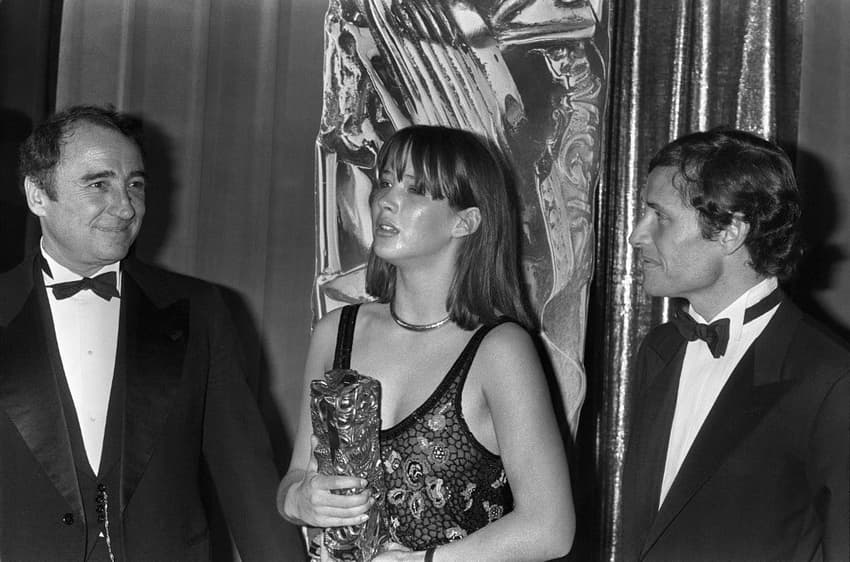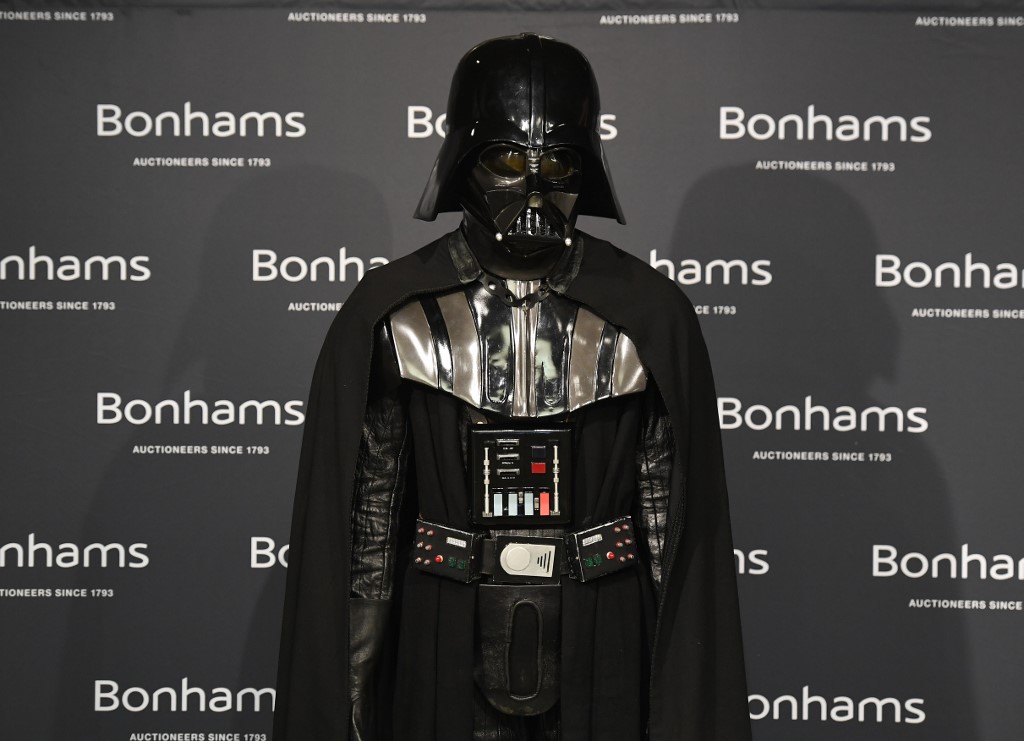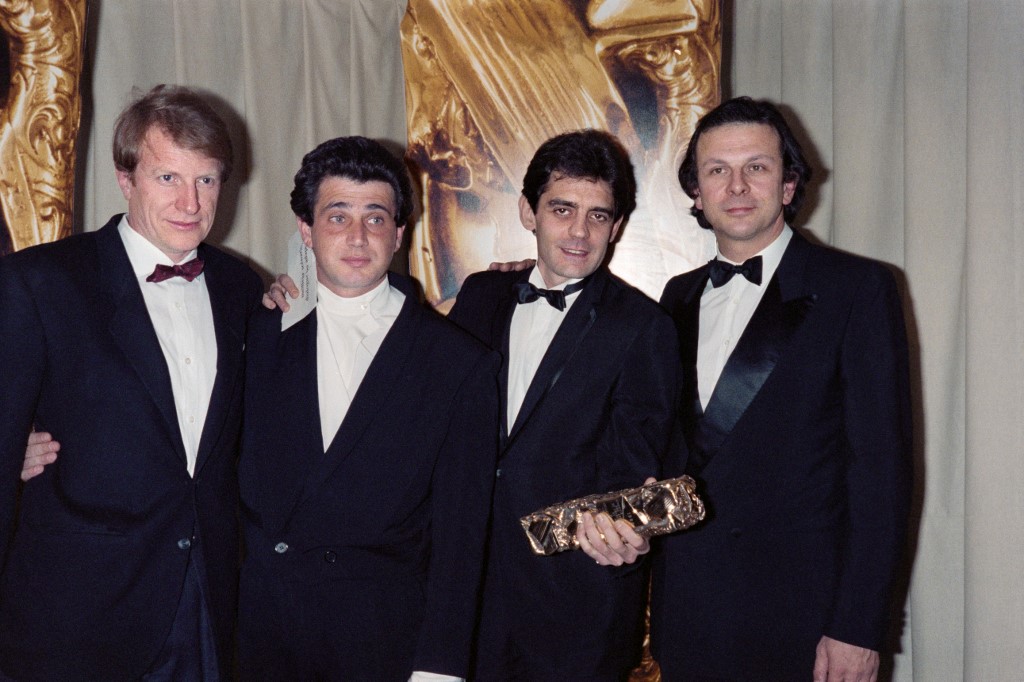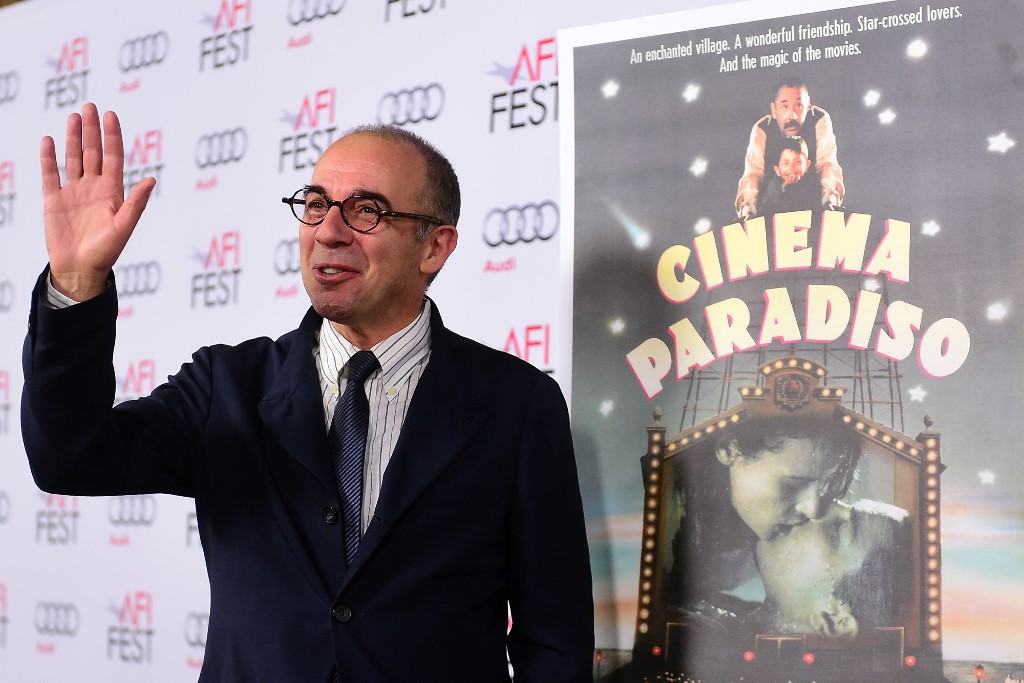Film blog: The French films breaking box office records in the 1980s

It’s hard to overestimate the influence that film had on kids and teens of the 1980s. Even 40 years later, the top films of the decade are fondly remembered - but there are some stark differences between what French and American audiences were watching, as Elizabeth Lanier finds out.
If you're looking to bond with a French person of a certain age, you might need to know what Cinéma Paradiso, La Boum and Les Ripoux are all about. For just as blockbusters and sci-fi dominated the Hollywood movie charts, these are the films that French people were enjoying in the 1980s.
READ ALSO Film blog: Why is American not keen on a 'French ending'?

George Lucas' Star Wars films went on to have one or two sequels. Photo: AFP
1980
USA: The Empire Strikes Back
In 1980, George Lucas changed the game with The Empire Strikes Back. Hollywood shifted to the blockbuster machine with which we are all familiar today. It isn’t that France doesn’t produce blockbusters, or that American movies aren’t an art form, but Empire definitely marked a shift in Hollywood.
France: La Boum
The top movie of that year in France could not be more different. La Boum tells the story of 13-year-old Vic, who wants to meet boys at her new high school at a boum (a big party). When her parents do not allow her to attend, Vic plots with her new friend and her grandmother and makes it to the party, where she falls in love with Matthieu.
It’s a classic which set up the teen romcom genre that defined the eighties. Boys fell in love with the lead actress - a young Sophie Marceau - and girls identified with Vic’s journey through first loves, newfound independence, and the humorous awkwardness of adolescence.
1981
USA: Raiders of the Lost Ark
Today, beloved archaeologist/adventurer “Indy” is an icon, and the film was deemed “culturally significant” by the Library of Congress and placed in the National Film Registry. This is the second time Harrison Ford and George Lucas’s films have appeared on this list, cementing their names in the halls of film history. After Raiders, the action-adventure genre changed, as the movie became the pinnacle and basis for the genre.
France: La Chèvre
La Chèvre is also an adventure comedy, but much goofier than Indiana Jones. It stars Gerard Depardieu and Pierre Richard, two iconic French actors, who paired up in many more movies. The plot is set up for misadventure: A daughter of a millionaire, distinguish by incredible bad luck, goes missing. The idea of how to find her is either insane or brilliant - to send after her an equally unlucky person.
1982
USA: E.T. the Extraterrestrial
Steven Spielberg's ET achieved international success and made its indelible mark on our childhoods in 1982. Not only was it popular worldwide, it was the number one film of the year in France as well as the US.
France: Les Misérables
The highest-grossing French movie of that year was Les Misérables, based on the Victor Hugo book of the same name. It’s a beloved and critically acclaimed adaptation of an iconic story, but the French audience still seemed to prefer the American film of the year.

Andre Dussolier, Michel Boujenah, Jean-François Lepetit and Roland Giraud won a César award for Trois Hommes et un Couffin (three men and a cradle) Photo: AFP
1983
USA: Risky Business
Risky Business was the movie of 1983 that we all remember, and hearing Old Time Rock and Roll still gives many people the urge to slide down a hallway in their socks. Starring Tom Cruse, it’s yet another coming-of-age movie, a genre that defined the 80s. Not only does it give us some iconic images, but it also reveals the corporate obsession of American culture.
France: L’Été Meurtrier
The French movie of that year, L’Été Meurtrier could not be more different. Elle moves to a small southern French town with her mother and disabled father. A mechanic immediately falls in love with her and they marry, but Elle is in town to solve the rape of her mother that happened long ago.
Elle slowly loses her grip on reality, and the tragic misunderstanding between her and her husband spirals out of control and ends in a murder. Set in the 1970s, it also evokes a kind of nostalgia with every shot, as well as the French affinity for eroticism and unpredictability in films.
1984
USA: Ghostbusters
The fourth in a row that was selected for preservation by the National Film Registry in America, and it’s no wonder. Immediately after its release, the theme song was a hit on the radio, and merchandise flew off the shelves, solidifying that particular marketing strategy that had first been introduced by The Empire Strikes Back. The format of Ghostbusters set up the action-comedy genre, and other films attempted to do the same thing: picking a genre and making a comedy of it. At the time, comedies were seen to be less profitable than other genres, but, as we can see today, they have become the most popular movies, thanks in part to Ghostbusters.
France: Les Ripoux
Les Ripoux exposes France’s less picturesque side through comedy. A “ripou” is a dirty cop, and the word itself is in verlan, the reversed French slang.
René, a cop, makes money by accepting bribes from criminals, and when his old partner gets busted, he tries to corrupt his new, young, and idealistic partner. This movie came at the beginning of major unrest in the banlieues and distrust of the police, so the themes resonated with many.
1985
USA: Back to the Future
Back to the Future defined 1985, as well as 1955. Both decades saw the rise of new subcultures; teen culture grew significantly due to Rock n’ Roll in the fifties and increased representation in pop culture in the eighties. Back to the Future was a major part of this, as we see Marty McFly skipping school and skateboarding instead.
France: Trois Hommes et un Couffin
This was remade in English two years later as Three Men and a Baby. It’s a more simple comedy, about three adult men who love their bachelor lives, when a woman drops a baby on their doorstep. It was the most popular French movie of the decade, with nine million attendees in theaters, more popular than Hollywood movies like E.T. or Raiders of the Lost Ark.
1986
USA: Ferris Bueller’s Day Off
Yet another high-school movie, Ferris Bueller’s Day Off premiered in 1986. The songs Twist and Shout and Oh Yeah became wildly popular after the premiere, and became symbols of teen freedom and rebellion. Ferris breaks from the archetype of “cool jock” or “lame nerd,” as he’s popular without being athletic. The film itself is a classic, like all the rest on this list, capturing the fleeting moment and defining what it meant to be a teenager bored with the drudgery of high school.
France: Jean de Florette and Manon des Sources
France was experiencing a different sort of moment in film that year, with the duo of Jean de Florette and Manon des Sources, that fall into the category of “Heritage Cinema.”
This was a film movement, primarily in the 1980s, that celebrate the history, culture, and landscape of France through period pieces. Part one, Jean de Florette, tells the story of a hunchback who comes to claim his inherited land in Provence. Part two, Manon des Sources, follows Jean’s daughter as an adult and her revenge plot on her old neighbors. Both movies are French classics and American high schoolers frequently watch them in their French classes.
1987
USA: The Princess Bride
The American movie of 1987 was a modest box office success at the time, but has since become a cult classic. It’s regarded as one of the most quotable films, and is beloved by both adults and children, men and women alike. Based on the book by William Goldman, The Princess Bride encapsulates childhood, nostalgia, and recalls to mind all the times we stayed home sick from school and watched this movie.
France: Au Revoir les Enfants
France’s movie of 1987 is much less lighthearted. Au Revoir Les Enfants - based on a true story - tells of a Catholic boarding school during World War II that secretly hides a few Jewish boys from the Gestapo. It’s not a Hollywood film by any stretch; some American audiences think it’s slower than it should be, but it’s a French classic, made for and by French people. It shows how powerful a movie can be without gratuitous violence, highlighting a major difference between French and American culture. It also shows how personally many French people were affected by the Nazis, and a part of French history that is less shown in media.
1988
USA: Die Hard
The jury is still out on whether or not it’s a Christmas movie, but everyone agrees that Die Hard is the quintessential action movie. What Indiana Jones did for adventure and Ghostbusters did for comedy, Die Hard did for action. It inspired the formula for action movies for the next 10 years, where the everyman must go up against a lively villain in an isolated setting. It’s been named as one of the best action films ever made, indulging in a male action fantasy with explosions, gunfire, and general “badassery.”
France: Le Grand Bleu
Le Grand Bleu inspired a generation, according to then-president Jacques Chirac. It was one of France’s most commercially successful movies due to its emotional intensity as well as its breathtakingly beautiful cinematography.
It focuses on the friendship and rivalry between two free divers and one of their relationships with his girlfriend. Like Trois Hommes et un couffin, it sold over nine million tickets in France and became a cult classic. Introspective and emotional, it was a flop in the US, even though they added a happier ending and changed the score for North American audiences.

Cinema Paradiso director Giuseppe Tornatore. Photo: AFP
1989
USA: Rain Man
1989’s Rain Man (Tom Cruise’s second appearance on this list) raised public awareness of autism. Though it warmed the hearts of its vast audience, autism advocates have criticised the trope of “autistic savant,” claiming it perpetuates false ideas about the condition. Despite such criticism, Rain Man took America by storm and dominates the popular conception of autism.
France: Cinéma Paradiso
France's most popular film of 1989 was actually Italian. It tells the story of a famous filmmaker who returns to his small childhood village in Sicily following news of the death of the village’s cinema projectionist who had inspired him to pursue film as a career. Like Au Revoir les Enfants and Le Grand Bleu, the story is introspective, without the Hollywood-esque dramatization or gratuitous violence or sex. But it’s a French and Italian classic, and probably revived Italy’s film industry.
Elizabeth Lanier works for Lost in Frenchlation, a Paris-based cinema club that screens French films with English subtitles, to open up the word of French cinema to English-speakers. Find out more about their programme here.
Comments
See Also
If you're looking to bond with a French person of a certain age, you might need to know what Cinéma Paradiso, La Boum and Les Ripoux are all about. For just as blockbusters and sci-fi dominated the Hollywood movie charts, these are the films that French people were enjoying in the 1980s.
READ ALSO Film blog: Why is American not keen on a 'French ending'?

George Lucas' Star Wars films went on to have one or two sequels. Photo: AFP
1980
USA: The Empire Strikes Back
In 1980, George Lucas changed the game with The Empire Strikes Back. Hollywood shifted to the blockbuster machine with which we are all familiar today. It isn’t that France doesn’t produce blockbusters, or that American movies aren’t an art form, but Empire definitely marked a shift in Hollywood.
France: La Boum
The top movie of that year in France could not be more different. La Boum tells the story of 13-year-old Vic, who wants to meet boys at her new high school at a boum (a big party). When her parents do not allow her to attend, Vic plots with her new friend and her grandmother and makes it to the party, where she falls in love with Matthieu.
It’s a classic which set up the teen romcom genre that defined the eighties. Boys fell in love with the lead actress - a young Sophie Marceau - and girls identified with Vic’s journey through first loves, newfound independence, and the humorous awkwardness of adolescence.
1981
USA: Raiders of the Lost Ark
Today, beloved archaeologist/adventurer “Indy” is an icon, and the film was deemed “culturally significant” by the Library of Congress and placed in the National Film Registry. This is the second time Harrison Ford and George Lucas’s films have appeared on this list, cementing their names in the halls of film history. After Raiders, the action-adventure genre changed, as the movie became the pinnacle and basis for the genre.
France: La Chèvre
La Chèvre is also an adventure comedy, but much goofier than Indiana Jones. It stars Gerard Depardieu and Pierre Richard, two iconic French actors, who paired up in many more movies. The plot is set up for misadventure: A daughter of a millionaire, distinguish by incredible bad luck, goes missing. The idea of how to find her is either insane or brilliant - to send after her an equally unlucky person.
1982
USA: E.T. the Extraterrestrial
Steven Spielberg's ET achieved international success and made its indelible mark on our childhoods in 1982. Not only was it popular worldwide, it was the number one film of the year in France as well as the US.
France: Les Misérables
The highest-grossing French movie of that year was Les Misérables, based on the Victor Hugo book of the same name. It’s a beloved and critically acclaimed adaptation of an iconic story, but the French audience still seemed to prefer the American film of the year.

Andre Dussolier, Michel Boujenah, Jean-François Lepetit and Roland Giraud won a César award for Trois Hommes et un Couffin (three men and a cradle) Photo: AFP
1983
USA: Risky Business
Risky Business was the movie of 1983 that we all remember, and hearing Old Time Rock and Roll still gives many people the urge to slide down a hallway in their socks. Starring Tom Cruse, it’s yet another coming-of-age movie, a genre that defined the 80s. Not only does it give us some iconic images, but it also reveals the corporate obsession of American culture.
France: L’Été Meurtrier
The French movie of that year, L’Été Meurtrier could not be more different. Elle moves to a small southern French town with her mother and disabled father. A mechanic immediately falls in love with her and they marry, but Elle is in town to solve the rape of her mother that happened long ago.
Elle slowly loses her grip on reality, and the tragic misunderstanding between her and her husband spirals out of control and ends in a murder. Set in the 1970s, it also evokes a kind of nostalgia with every shot, as well as the French affinity for eroticism and unpredictability in films.
1984
USA: Ghostbusters
The fourth in a row that was selected for preservation by the National Film Registry in America, and it’s no wonder. Immediately after its release, the theme song was a hit on the radio, and merchandise flew off the shelves, solidifying that particular marketing strategy that had first been introduced by The Empire Strikes Back. The format of Ghostbusters set up the action-comedy genre, and other films attempted to do the same thing: picking a genre and making a comedy of it. At the time, comedies were seen to be less profitable than other genres, but, as we can see today, they have become the most popular movies, thanks in part to Ghostbusters.
France: Les Ripoux
Les Ripoux exposes France’s less picturesque side through comedy. A “ripou” is a dirty cop, and the word itself is in verlan, the reversed French slang.
René, a cop, makes money by accepting bribes from criminals, and when his old partner gets busted, he tries to corrupt his new, young, and idealistic partner. This movie came at the beginning of major unrest in the banlieues and distrust of the police, so the themes resonated with many.
1985
USA: Back to the Future
Back to the Future defined 1985, as well as 1955. Both decades saw the rise of new subcultures; teen culture grew significantly due to Rock n’ Roll in the fifties and increased representation in pop culture in the eighties. Back to the Future was a major part of this, as we see Marty McFly skipping school and skateboarding instead.
France: Trois Hommes et un Couffin
This was remade in English two years later as Three Men and a Baby. It’s a more simple comedy, about three adult men who love their bachelor lives, when a woman drops a baby on their doorstep. It was the most popular French movie of the decade, with nine million attendees in theaters, more popular than Hollywood movies like E.T. or Raiders of the Lost Ark.
1986
USA: Ferris Bueller’s Day Off
Yet another high-school movie, Ferris Bueller’s Day Off premiered in 1986. The songs Twist and Shout and Oh Yeah became wildly popular after the premiere, and became symbols of teen freedom and rebellion. Ferris breaks from the archetype of “cool jock” or “lame nerd,” as he’s popular without being athletic. The film itself is a classic, like all the rest on this list, capturing the fleeting moment and defining what it meant to be a teenager bored with the drudgery of high school.
France: Jean de Florette and Manon des Sources
France was experiencing a different sort of moment in film that year, with the duo of Jean de Florette and Manon des Sources, that fall into the category of “Heritage Cinema.”
This was a film movement, primarily in the 1980s, that celebrate the history, culture, and landscape of France through period pieces. Part one, Jean de Florette, tells the story of a hunchback who comes to claim his inherited land in Provence. Part two, Manon des Sources, follows Jean’s daughter as an adult and her revenge plot on her old neighbors. Both movies are French classics and American high schoolers frequently watch them in their French classes.
1987
USA: The Princess Bride
The American movie of 1987 was a modest box office success at the time, but has since become a cult classic. It’s regarded as one of the most quotable films, and is beloved by both adults and children, men and women alike. Based on the book by William Goldman, The Princess Bride encapsulates childhood, nostalgia, and recalls to mind all the times we stayed home sick from school and watched this movie.
France: Au Revoir les Enfants
France’s movie of 1987 is much less lighthearted. Au Revoir Les Enfants - based on a true story - tells of a Catholic boarding school during World War II that secretly hides a few Jewish boys from the Gestapo. It’s not a Hollywood film by any stretch; some American audiences think it’s slower than it should be, but it’s a French classic, made for and by French people. It shows how powerful a movie can be without gratuitous violence, highlighting a major difference between French and American culture. It also shows how personally many French people were affected by the Nazis, and a part of French history that is less shown in media.
1988
USA: Die Hard
The jury is still out on whether or not it’s a Christmas movie, but everyone agrees that Die Hard is the quintessential action movie. What Indiana Jones did for adventure and Ghostbusters did for comedy, Die Hard did for action. It inspired the formula for action movies for the next 10 years, where the everyman must go up against a lively villain in an isolated setting. It’s been named as one of the best action films ever made, indulging in a male action fantasy with explosions, gunfire, and general “badassery.”
France: Le Grand Bleu
Le Grand Bleu inspired a generation, according to then-president Jacques Chirac. It was one of France’s most commercially successful movies due to its emotional intensity as well as its breathtakingly beautiful cinematography.
It focuses on the friendship and rivalry between two free divers and one of their relationships with his girlfriend. Like Trois Hommes et un couffin, it sold over nine million tickets in France and became a cult classic. Introspective and emotional, it was a flop in the US, even though they added a happier ending and changed the score for North American audiences.

Cinema Paradiso director Giuseppe Tornatore. Photo: AFP
1989
USA: Rain Man
1989’s Rain Man (Tom Cruise’s second appearance on this list) raised public awareness of autism. Though it warmed the hearts of its vast audience, autism advocates have criticised the trope of “autistic savant,” claiming it perpetuates false ideas about the condition. Despite such criticism, Rain Man took America by storm and dominates the popular conception of autism.
France: Cinéma Paradiso
France's most popular film of 1989 was actually Italian. It tells the story of a famous filmmaker who returns to his small childhood village in Sicily following news of the death of the village’s cinema projectionist who had inspired him to pursue film as a career. Like Au Revoir les Enfants and Le Grand Bleu, the story is introspective, without the Hollywood-esque dramatization or gratuitous violence or sex. But it’s a French and Italian classic, and probably revived Italy’s film industry.
Elizabeth Lanier works for Lost in Frenchlation, a Paris-based cinema club that screens French films with English subtitles, to open up the word of French cinema to English-speakers. Find out more about their programme here.
Join the conversation in our comments section below. Share your own views and experience and if you have a question or suggestion for our journalists then email us at [email protected].
Please keep comments civil, constructive and on topic – and make sure to read our terms of use before getting involved.
Please log in here to leave a comment.